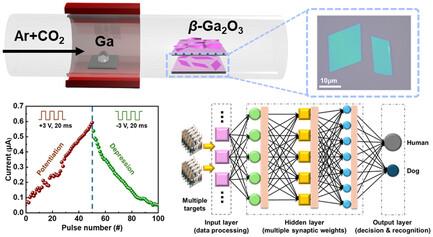用于人工神经形态应用的超薄二维 β-Ga2O3 纳米片的空间限制生长
IF 11.1
Q1 MATERIALS SCIENCE, MULTIDISCIPLINARY
引用次数: 0
摘要
近年来,宽带隙半导体材料β-Ga2O3因其优异的性能而被广泛研究。与此同时,二维金属氧化物(2DMOs)也因其卓越的稳定性和量子约束效应所产生的独特物理性质而成为研究的焦点。因此,对二维 β-Ga2O3 的探索有望揭示其在电子应用中的新颖电学特性。然而,合成高质量的二维 β-Ga2O3 仍然是一项艰巨的挑战。本文通过加强化学气相沉积过程的动力学控制,构建了一个密闭空间来合成高质量的二维β-Ga2O3纳米片。装置结果表明,生长出的纳米片具有优异的开关特性和潜在的人工突触响应特性。在此基础上,开发出了手写数字人工识别系统,其峰值识别准确率达到约 96%。该系统在为高级驾驶辅助系统定制的新兴神经形态识别框架中具有巨大的应用潜力。这项工作为合成二维非层状氧化物提供了一条新的可行途径,并展示了二维氧化物在神经模拟电子学和识别领域的潜力,从而推动了二维 β-Ga2O3 电子学和二维多微米氧化物电子学领域的发展。本文章由计算机程序翻译,如有差异,请以英文原文为准。

Space-Confined Growth of Ultrathin 2D β-Ga2O3 Nanoflakes for Artificial Neuromorphic Application
In recent years, wide-bandgap semiconductor β-Ga2O3 material has been widely studied because of its excellent properties. Simultaneously, 2D metal oxides (2DMOs) have also become a focus of research owing to their superior stability and unique physical properties arising from quantum confinement effects. Therefore, the exploration of 2D β-Ga2O3 is expected to reveal its novel electrical properties in electronic applications. However, the synthesis of high-quality 2D β-Ga2O3 remains a formidable challenge. Herein, a confined space is constructed to synthesize high-quality 2D β-Ga2O3 nanoflakes by enhancing the control of the kinetics of chemical vapor deposition process. In the device results, it is shown that the grown nanoflakes have excellent switching properties and potential artificial synaptic response characteristics. Based on this premise, an artificial recognition system for handwritten numerals is developed, achieving a peak recognition accuracy of approximately 96%. This system holds significant potential for application within an emerging neuromorphic recognition framework tailored for advanced driver-assistance systems. In this work, a new feasible pathway is provided for the synthesis of 2D non-layered oxides and the potential of 2D oxides in the field of neuroanalog electronics and recognition is shown, thereby advancing the fields of 2D β-Ga2O3 electronics and 2DMOs electronics.
求助全文
通过发布文献求助,成功后即可免费获取论文全文。
去求助
来源期刊
CiteScore
14.00
自引率
2.40%
发文量
0
期刊介绍:
Small Science is a premium multidisciplinary open access journal dedicated to publishing impactful research from all areas of nanoscience and nanotechnology. It features interdisciplinary original research and focused review articles on relevant topics. The journal covers design, characterization, mechanism, technology, and application of micro-/nanoscale structures and systems in various fields including physics, chemistry, materials science, engineering, environmental science, life science, biology, and medicine. It welcomes innovative interdisciplinary research and its readership includes professionals from academia and industry in fields such as chemistry, physics, materials science, biology, engineering, and environmental and analytical science. Small Science is indexed and abstracted in CAS, DOAJ, Clarivate Analytics, ProQuest Central, Publicly Available Content Database, Science Database, SCOPUS, and Web of Science.

 求助内容:
求助内容: 应助结果提醒方式:
应助结果提醒方式:


